Ditapis dengan
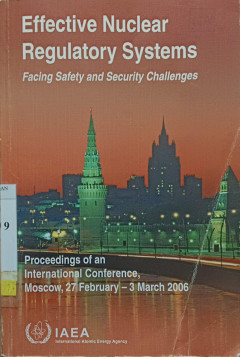
EFFECTIVE Nuclear Regulatory System
Independence and regulatory effectiveness; regulatory safety challenges; regulatory security challenges; enchanged International regulatory cooperation; regulatory effectivenes from the operations viewpoint.
- Edisi
- -
- ISBN/ISSN
- 92-0-1-110606-8
- Deskripsi Fisik
- 331 p. : ill. ; 21 cm
- Judul Seri
- -
- No. Panggil
- PRO 363.179 9 EFE
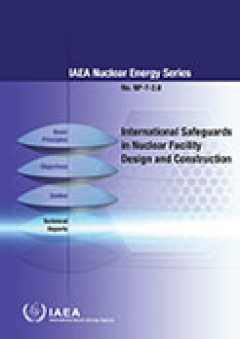
International Safeguards in Nuclear Facility Design and Construction: IAEA Nu…
This IAEA publication provides guidance on the inclusion of safeguards considerations in nuclear facility design and construction. This first volume introduces the basic principles of safeguards by design and discusses the goals, costs and rewards, and places the information into the context of nuclear facility design and construction. Benefits and opportunities for all stakeholders are emphasi…
- Edisi
- -
- ISBN/ISSN
- 978-92-0-140610-1
- Deskripsi Fisik
- 22 p.; 30 cm.
- Judul Seri
- IAEA Nuclear Energy Series
- No. Panggil
- 621.483 IAE i (2)
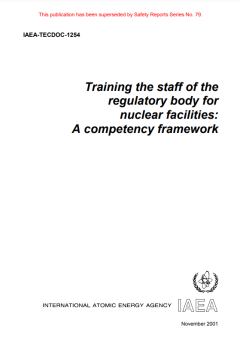
Training the Staff of the Regulatory Body for Nuclear Facilities: A Competenc…
Safety Requirements for legal and Governmental Infrastructure for Nuclear, Radiation, Radioactive Waste and Transport Safety [1] address the issues of competencies and training of the regulatory body by requiring that: “In order to ensure that the proper skills are acquired and that adequate levels of competencies are achieved and maintained, the regulatory body shall ensure that its staff me…
- Edisi
- -
- ISBN/ISSN
- 10114289
- Deskripsi Fisik
- 135 p. : Illus. ; 29 cm
- Judul Seri
- IAEA-TECDOC-1254
- No. Panggil
- 658.31244
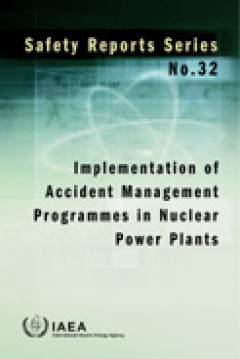
Implementation of Accident Management Programmes in Nuclear Power Plants | Sa…
This publication provides a description of the elements which should be addressed by the team responsible for the preparation, development and implementation of a plant specific accident management programme at a nuclear power plant. The issues addressed include formation of the team, selection of accident management strategies, safety analyses required, evaluation of the performance of plant s…
- Edisi
- 32
- ISBN/ISSN
- 92-0-113803-2
- Deskripsi Fisik
- 121p ; 582kb
- Judul Seri
- -
- No. Panggil
- 621.483 IAE I
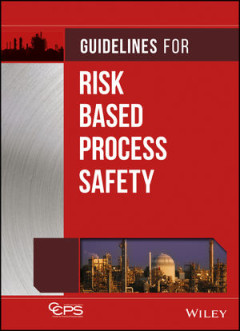
Guidelines for Risk Based Process Safety
Guidelines for Risk Based Process Safety provides guidelines for industries that manufacture, consume, or handle chemicals, by focusing on new ways to design, correct, or improve process safety management practices. This new framework for thinking about process safety builds upon the original process safety management ideas published in the early 1990s, integrates industry lessons learned over …
- Edisi
- -
- ISBN/ISSN
- 9780470165690
- Deskripsi Fisik
- iv, 698 p. : Illus. ; 25 cm
- Judul Seri
- -
- No. Panggil
- 660.2804 CHE g
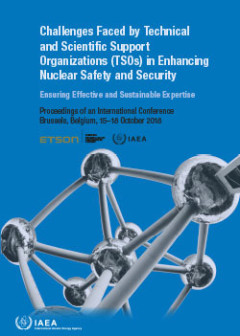
Challenges Faced by Technical and Scientific Support Organizations (TSOs) in …
The global nuclear safety and security framework (GNSSF) provides a conceptual structure and guidelines for achieving and maintaining a high level of safety and security at nuclear facilities and in nuclear related activities around the world. Technical and scientific support organizations (TSOs) play an essential role in sustaining the GNSSF by providing assistance to regulatory bodies in esta…
- Edisi
- -
- ISBN/ISSN
- 978-92-0-121021-0
- Deskripsi Fisik
- 258 p
- Judul Seri
- Proceedings Series - International Atomic Energy Agency
- No. Panggil
- 621.039.58 IAE c
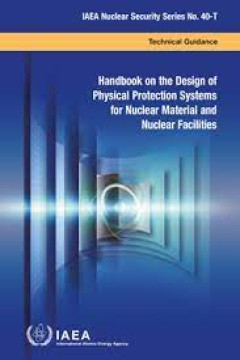
Handbook on the Design of Physical Protection Systems for Nuclear Material an…
This publication provides comprehensive detailed guidance for States, competent authorities and operators on how to implement the recommendations and implementing guidance of existing IAEA Nuclear Security Series publications for an effective physical protection system (PPS) for nuclear facilities and nuclear materials in use and storage. It provides further technical detail on how to design an…
- Edisi
- 2021
- ISBN/ISSN
- 978-92-0-100120-7
- Deskripsi Fisik
- 200 p
- Judul Seri
- IAEA Nuclear Security Series No. 40-T
- No. Panggil
- 621.039.58
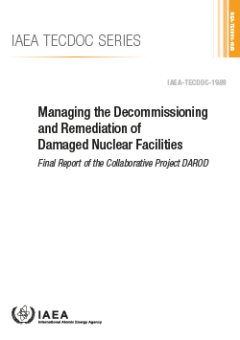
Managing the decommissioning and remediation of damaged nuclear facilities - …
In response to the accident at the Fukushima Daiichi nuclear power plant in March 2011, the IAEA developed the IAEA Action Plan on Nuclear Safety. One of the objectives of the plan was to ensure that, following a nuclear emergency, people and the environment are protected from ionizing radiation. One of the activities undertaken to address this objective was the International Project on Mana…
- Edisi
- 2021
- ISBN/ISSN
- 978-92-0-142521-8
- Deskripsi Fisik
- 136 p
- Judul Seri
- -
- No. Panggil
- 539.7 IAE m
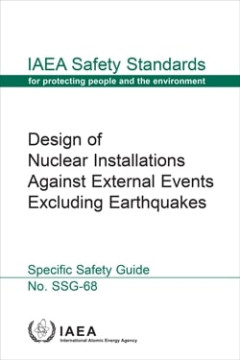
Design of Nuclear Installations Against External Events Excluding Earthquakes…
The status of the IAEA safety standards derives from the IAEA’s Statute, which authorizes the IAEA to establish or adopt, in consultation and, where appropriate, in collaboration with the competent organs of the United Nations and with the specialized agencies concerned, standards of safety for protection of health and minimization of danger to life and property, and to provide for their appl…
- Edisi
- IAEA Safety Standards Series.
- ISBN/ISSN
- 978-92-0-136121-9
- Deskripsi Fisik
- 112 p
- Judul Seri
- IAEA Safety Standards Series.
- No. Panggil
- 621.039.58 IAE d
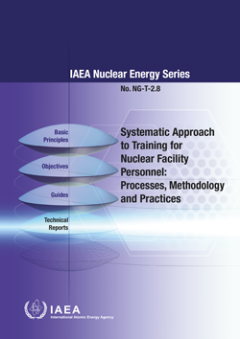
Systematic Approach to Training for Nuclear Facility Personnel: Processes, Me…
Training is an important tool to achieve and maintain the required competence of personnel working in nuclear facilities. Effective training and qualification of personnel are necessary for the achievement of high safety and efficiency standards in nuclear facility performance. Training and qualification combined is a key feature of the integrated management systems of nuclear facilities. It is…
- Edisi
- -
- ISBN/ISSN
- 978-92-0-113320-5
- Deskripsi Fisik
- 171 Pages
- Judul Seri
- -
- No. Panggil
- -
 Karya Umum
Karya Umum  Filsafat
Filsafat  Agama
Agama  Ilmu-ilmu Sosial
Ilmu-ilmu Sosial  Bahasa
Bahasa  Ilmu-ilmu Murni
Ilmu-ilmu Murni  Ilmu-ilmu Terapan
Ilmu-ilmu Terapan  Kesenian, Hiburan, dan Olahraga
Kesenian, Hiburan, dan Olahraga  Kesusastraan
Kesusastraan  Geografi dan Sejarah
Geografi dan Sejarah